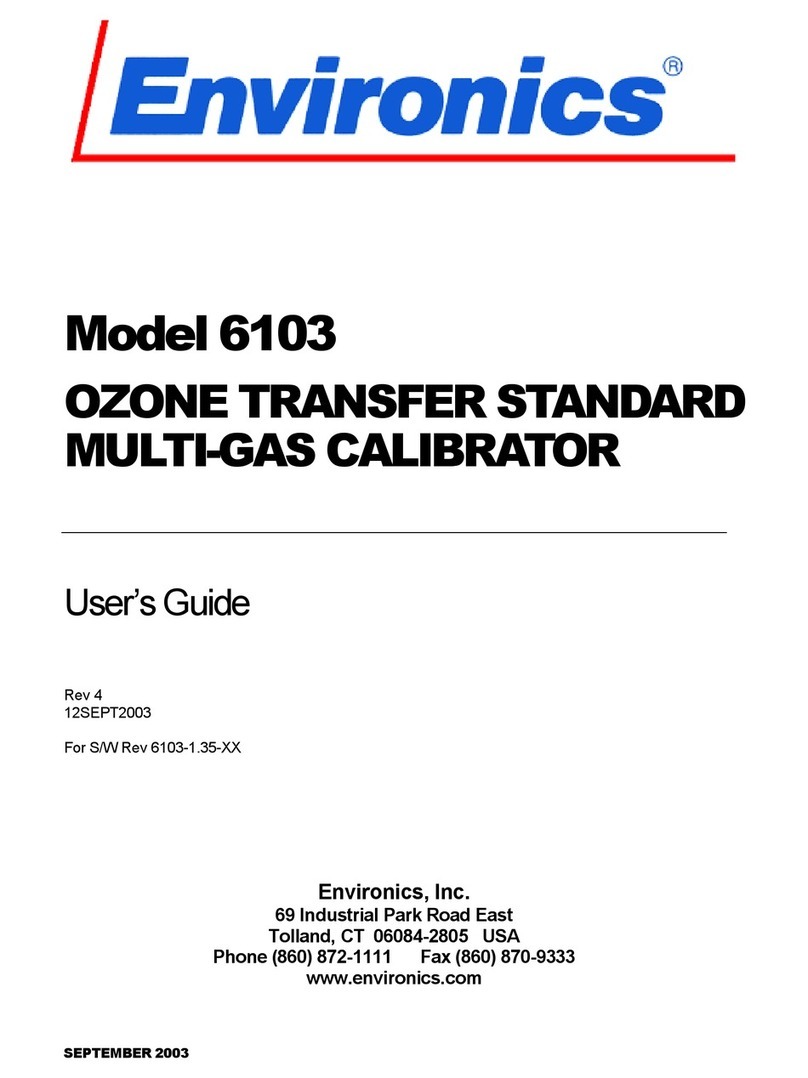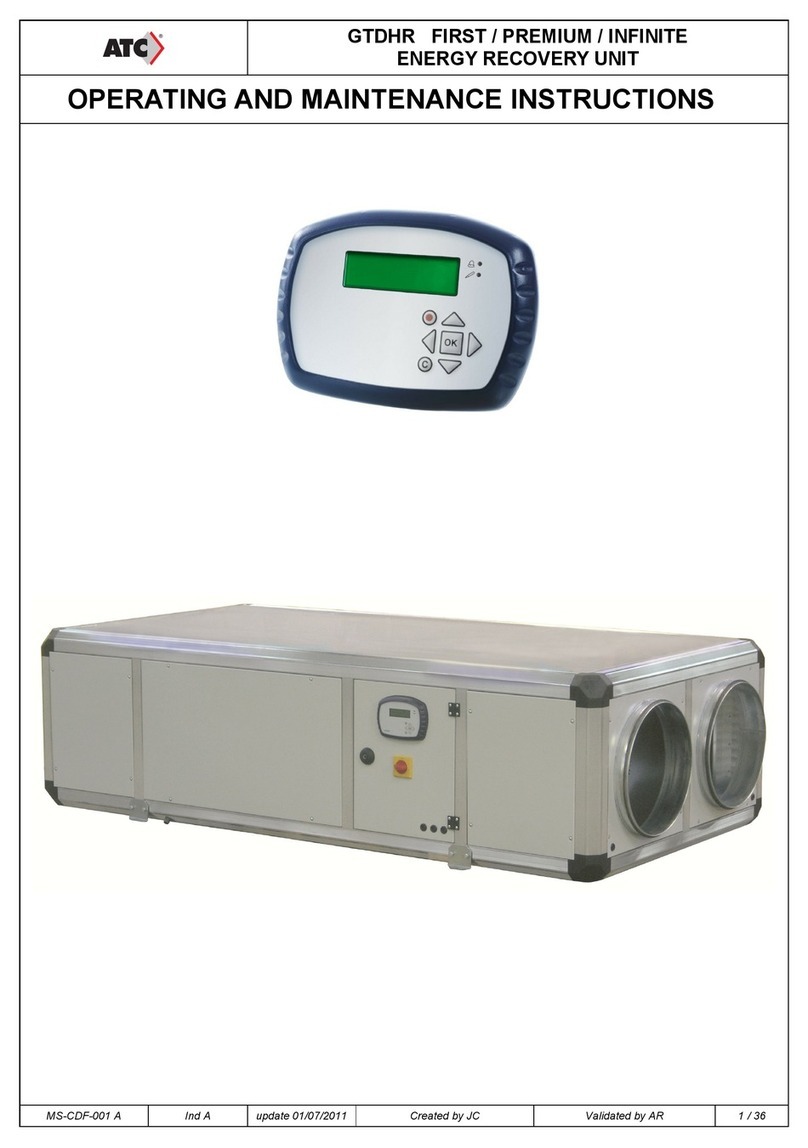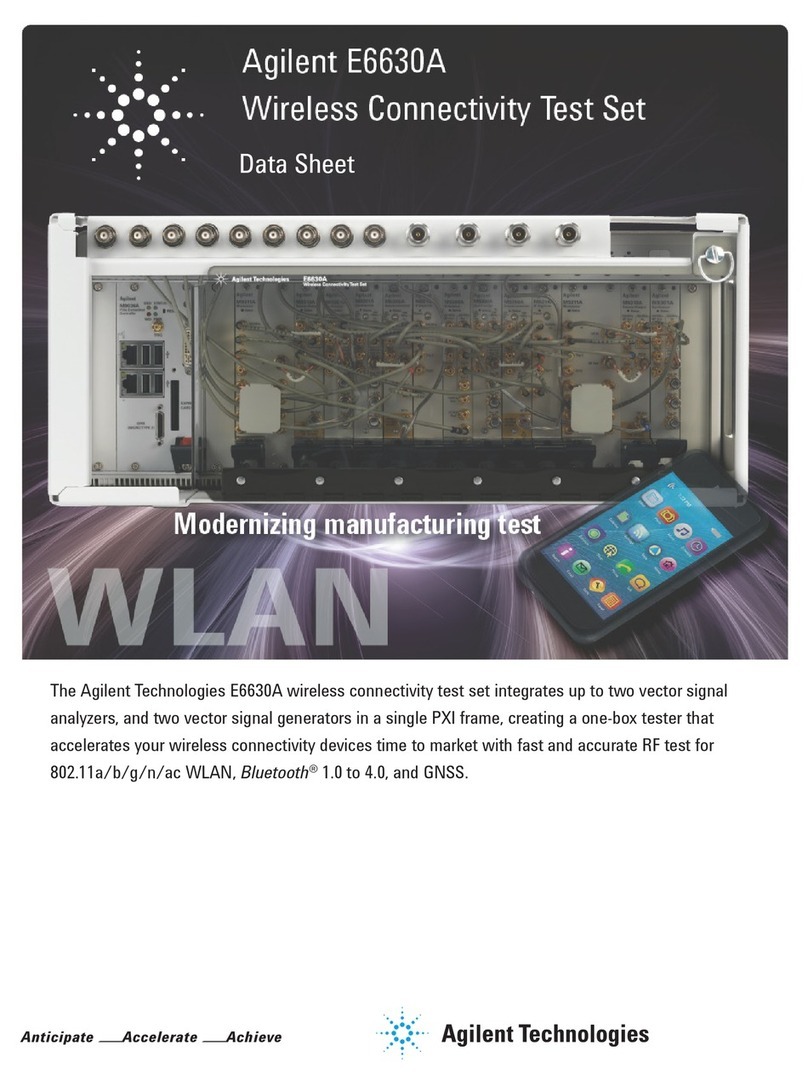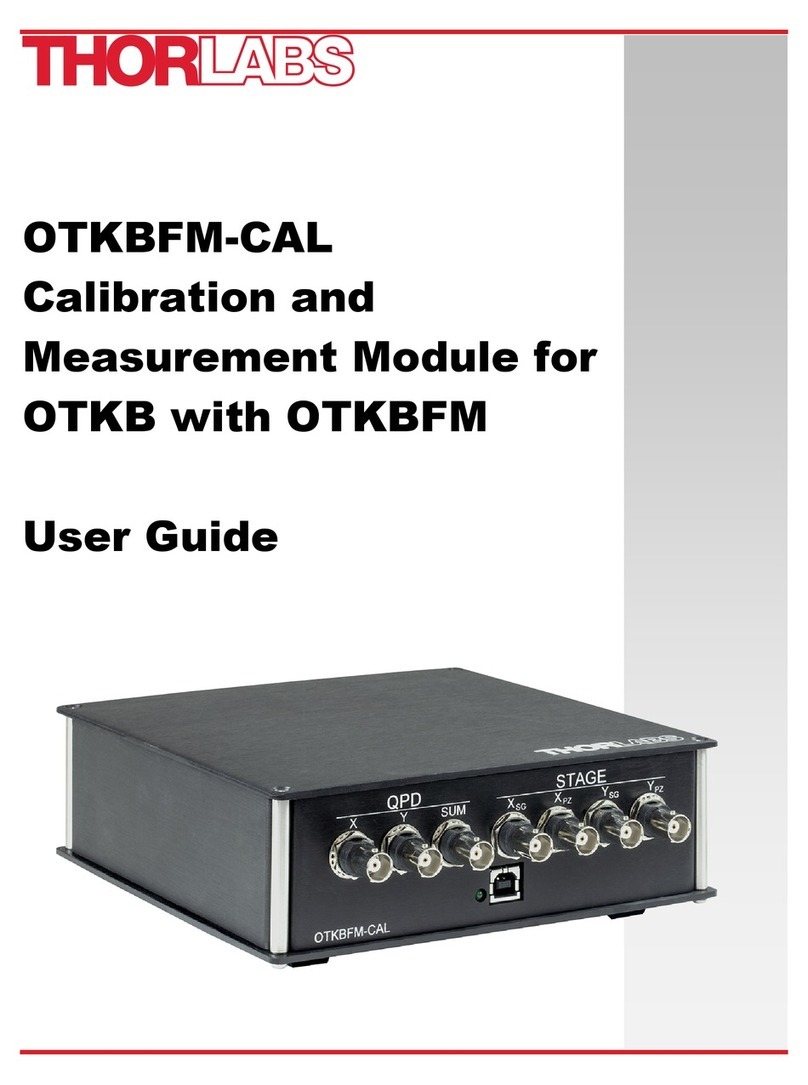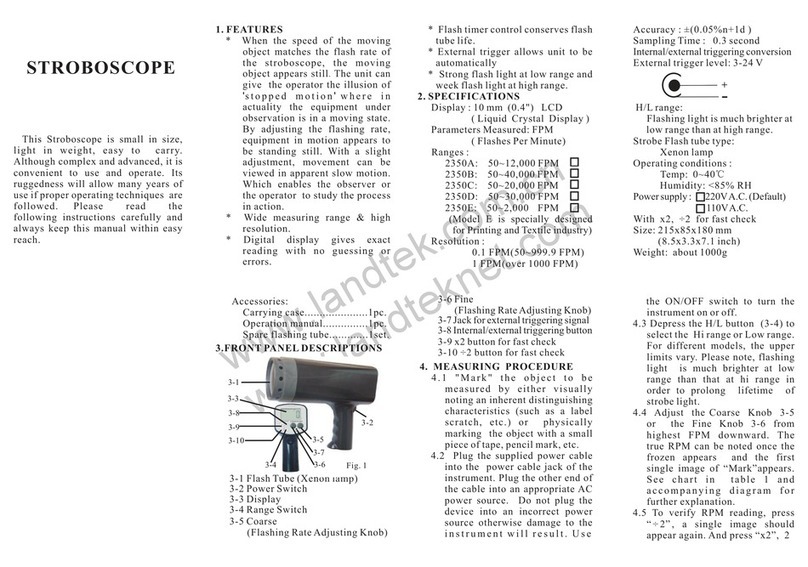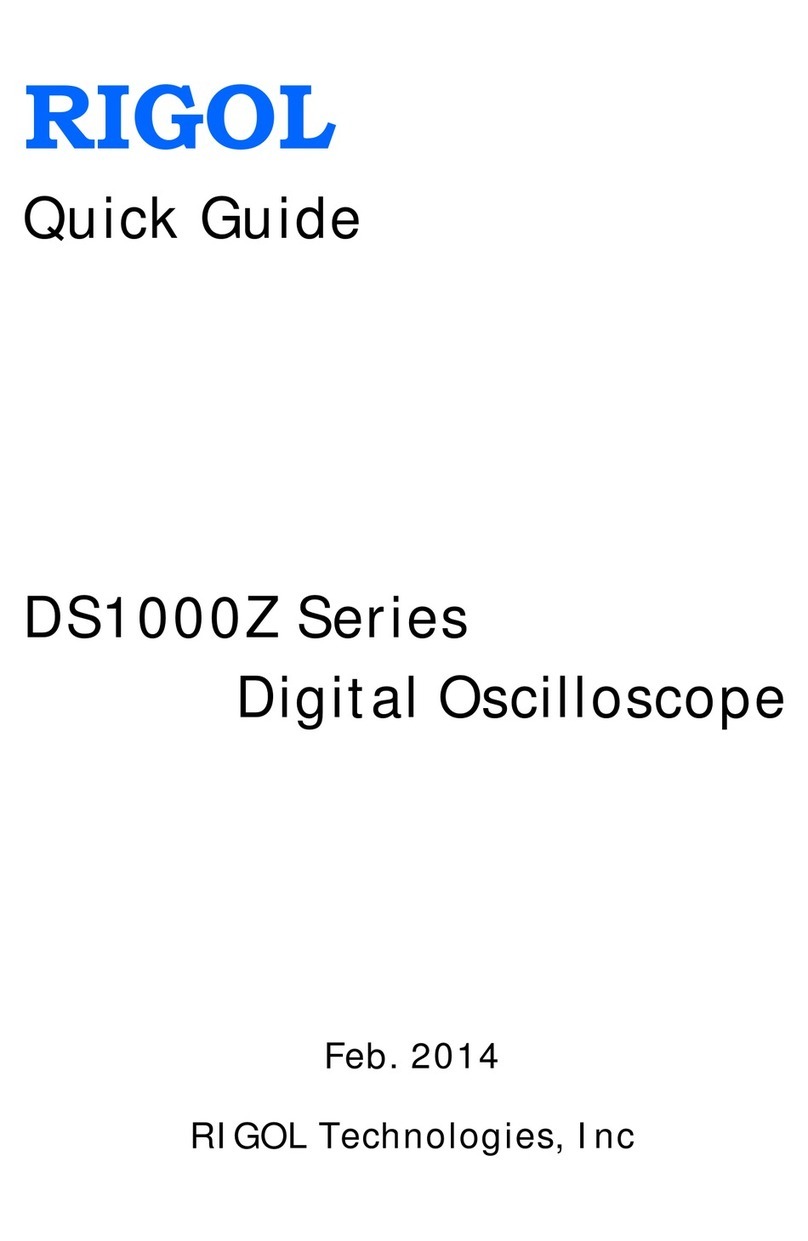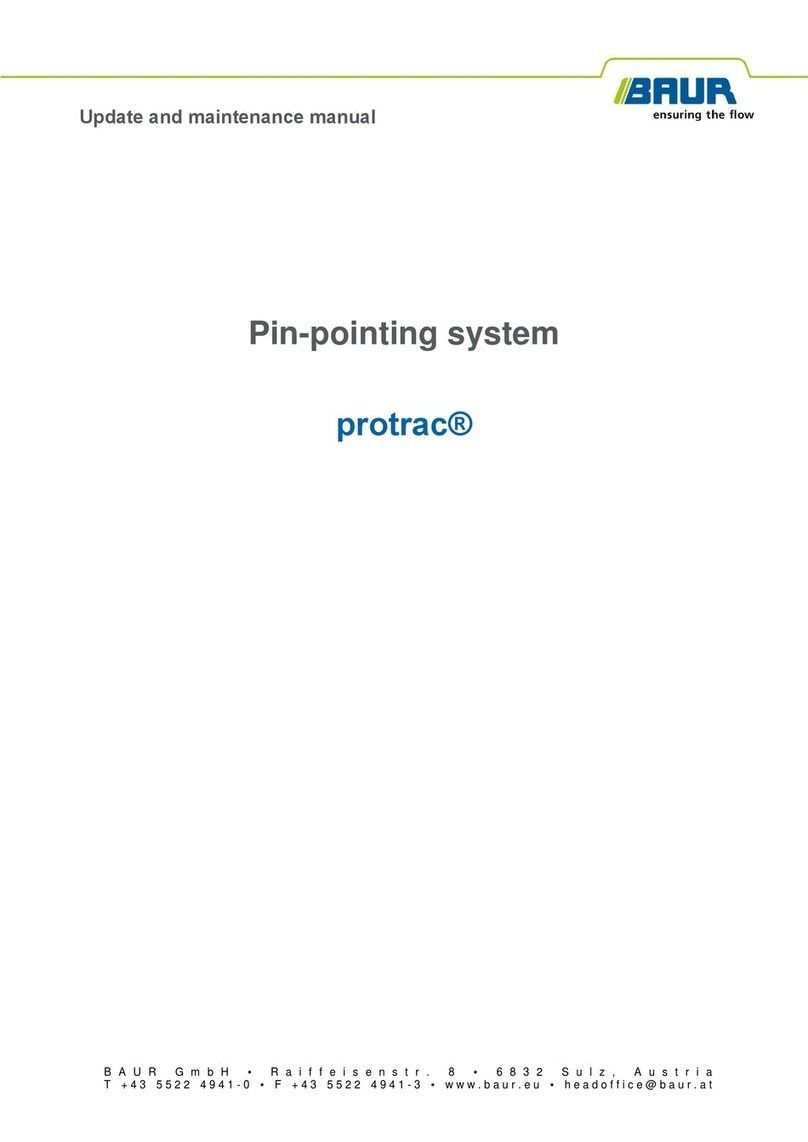Environics 6100 Series User manual

6100 USER’S GUIDE i REV15 -FEB2021
COPYRIGHT
© 2003-2021 Environics Inc. All Rights Reserved. This manual and the software contained
within the product(s) described are copyrighted with all rights reserved.
TRADEMARKS
Environics is a registered trademark of Environics Inc. All other brand names, company
names and product names mentioned are the property of their respective owners.
WARRANTY
Environics, Inc. warrants this product to be free from defects in material and workmanship for
a period of one year from the date of shipment. Environics warrants the following expendable
items for 30 days from the date of shipment: fuses, lamps, batteries. During the warranty
period, Environics will, at our option, either repair or replace any product that proves to be
defective.
To exercise this warranty, contact Environics at the address below for assistance and
instructions for returning the products. Repaired or replaced products are warranted for the
balance of the original warranty period or at least 30 days.
LIMITATION OF WARRANTY
This warranty does not apply to defects resulting from product modification made without
Environics’ express written consent, or misuse of any product or part. This warranty also does
not apply to software, damage from battery leakage or problems arising from normal wear or
failure to follow instructions.
This warranty is in lieu of all other warranties, expressed or implied, including any implied
warranty of merchantability or fitness for a particular use. The remedies provided herein are
the buyer’s sole and exclusive remedies.
Neither Environics nor any of its employees shall be liable for any direct, indirect, special,
incidental or consequential damages arising out of the use of its instruments and software
even if Environics has been advised in advance of the possibility of such damages. Such
excluded damages shall include, but are not limited to: costs of removal and installation,
losses sustained as the result of injury to any person or damage to property.
WARNING
READ THIS MANUAL CAREFULLY BEFORE USING THIS INSTRUMENT.
FAILURE TO DO SO MAY VOID THE WARRANTY,
DAMAGE THE INSTRUMENT OR CAUSE SERIOUS INJURY.
Environics Inc.
69 Industrial Park Road East
Tolland, CT 06084-2805 U.S.A.
Phone: (860) 872-1111 Fax: (860) 870-9333
WWW.ENVIRONICS.COM

6100 USER’S GUIDE ii REV15 -FEB2021
6100 User’s Manual changes
Manual
Revision
#
Software
Revision
#
Manual
Release
Date
Enhancements
3
1.28-03
03FEB2003
Initial release
4
1.28-04
31MAR2003
Page 19 –Way in which contrast adjustment works.
Added requirements for UL listing to preface
Added this page to log changes.
5
1.30-01
01JUL2003
Enhanced Status Output Mode - Pages 18, 36
Added flow mode remote commands –Page 31
Adjusted indexes and page references for addition of page in Remote
mode section; now pages 28-32
6
1.31-01
15SEP2003
N/A
7
1.32-01
23DEC2003
Additional status output programming options
8
1.33-02
23APR2004
Added section for Program Mode
Updated status input section, to include programming options.
Combined two status output sections into one.
Added automatic Table of Contents
Combined separate power warning sec. with power connection sec.
Added automatic Table of Figures (List of illustrations)
9
1.33-03
10NOV2004
Added SKIP and RUNNOW buttons to Run Schedule screen
Added SCHEDULE 1 as an option for Powerup Mode preference
10
1.34-01
31MAR2007
Added IDLE TIMER to Setting User Preferences section
11
1.35-01
03MAY2010
Changes to ozone preburn operation
Added information on serial data output
12
1.35-xx
14OCT2011
Adjusted power cable diagram, page 76
Updated MFC3 (optional) calibration information
Added P&ID for Series 6100 with optional MFC3
13
1.36-xx
10SEP2013
Added Remote Gas commands
14
1.36-xx and
2.01-xx
09OCT2019
Updated Ozone Calibration instructions

6100 USER’S GUIDE iii REV15 -FEB2021
SERIES 6100
MULTI-GAS CALIBRATOR
ENVIRONICS, INC
69 INDUSTRIAL PARK ROAD EAST
TOLLAND, CT 06084
EQUIPMENT SUMMARY –TYPE:
(X) Measurement; ( ) Control; ( ) Laboratory
Marked electrical rating:
115 VAC, 50/60 Hz, T2.0A FUSE TYPE T2.0/125
230 VAC, 50/60 Hz, T1.0A FUSE TYPE T1.0/250
Connection to Supply: Standard IEC Inlet Coupler/Cord Connected
Environmental rating: Standard
Operating temperature range: 0-50oC
Performance Temperature range: 15-35oC
Humidity: <95% RH @ 15-30 deg C
Altitude: up to 2000 Meters
Warmup Time 30 Minutes
Installation Category II,
Pollution Degree:2
Equipment Class 1
Equipment function/feature/description:
S6000 was designed for precision Multi-Gas Calibrations with Ozone.
Mode of operation:
Concentration Mode, Flow Mode, Program Mode, Calibrate Mode.
Degree of mobility:
( ) Permanently Connected; (X) Other Cord Connected.
Overall size: 17”x7”x15” Weight: 27 lbs.
Ventilation requirements:
Do not cover or block the ventilation holes in the top cover or fan filter on
the rear panel.

6100 USER’S GUIDE iv REV15 -FEB2021
TABLE OF CONTENTS
LIST OF ILLUSTRATIONS v
LIST OF ABBREVIATIONS / ACRONYMS vi
FORWARD 1
UNPACKING AND INSPECTING THE SYSTEM 2
SYSTEM LAYOUT 3
FRONT PANEL LAYOUT 3
REAR PANEL LAYOUT 5
POWER AND GAS CONNECTIONS 9
POWER CONNECTION 10
GAS CONNECTIONS 11
SYSTEM OVERVIEW AND SETUP 12
OPERATING MODE SUMMARY 12
ENTERING DATA 14
MAIN SCREEN (READY) 15
GASES SETUP MODE (GASES) 16
RUNNING THE SYSTEM 19
SYSTEM WARMUP 19
CONCENTRATION MODE (CONC) 19
FLOW MODE (FLOW) 23
PROGRAM MODE 25
SETTING USER PREFERENCES 31
CONNECTING TO OTHER DEVICES 37
STATUS INPUT 37
STATUS OUTPUT 41
SERIAL PORTS 43
REMOTE MODE (REMOTE) 44
INTERFACE SPECIFICATION 44
REMOTE MODE COMMAND LIST 46
REMOTE MODE ERROR CODES 49
TECHNICAL MANUAL 50
THEORY OF OPERATION 50
GAS PHASE TITRATION 51
SYSTEM CALIBRATION 52
PCB FUNCTION and TEST POINTS 62
TEST POINT WAVEFORMS 68
TROUBLESHOOTING 70
DIAGRAMS AND SCHEMATICS 77

6100 USER’S GUIDE v REV15 -FEB2021
LIST OF ILLUSTRATIONS
FIGURE 1 - FRONT PANEL LAYOUT..................................................................3
FIGURE 2 - REAR PANEL LAYOUT....................................................................5
FIGURE 3 - INTERNAL LAYOUT (STANDARD 6100 WITH 2 MFCS)................6
FIGURE 4 - MFC ILLUSTRATION......................................................................57
FIGURE 5 - TEST POINT WAVEFORMS...........................................................68
FIGURE 6 - POWER CABLE DIAGRAM............................................................77
FIGURE 7 - PIPING AND INSTRUMENT DIAGRAM - STANDARD...................87
FIGURE 8 - PIPING AND INSTRUMENT DIAGRAM - OPTIONS......................90

6100 USER’S GUIDE vi REV15 -FEB2021
LIST OF ABBREVIATIONS / ACRONYMS
AC Alternating Current
ADC Analog to Digital Converter
CCM Cubic Centimeter Per Minute
CGC Cylinder Gas Concentration
DAC Digital to Analog Converter
EMI Electromagnetic Interference
EPA Environmental Protection Agency
Hz Hertz
lbs Pounds
LCD Liquid Crystal Display
LPM Liters Per Minute
MFC Mass Flow Controller
NIST National Institute of Standards and Technology
OGC Output Gas Concentration
P&ID Piping and Instrument Diagram
PPB Parts Per Billion
PPM Parts Per Million
PSIA Pounds per Square Inch Absolute
PSIG Pounds per Square Inch Gauge
RFI Radio frequency interference
SCCM Standard Cubic Centimeters per Minute
SLPM Standard Liters Per Minute
UHP Ultra High Purity
VAC Volts, Alternating Current
VDC Volts, Direct Current

FORWARD
6100 USER’S GUIDE 1 REV15 -FEB2021
FORWARD
The Environics Series 6100 Multi-gas Calibrator
was designed to be the finest instrument available
for producing highly precise mixtures of ozone and
other gases. The system incorporates user-friendly
software, mass flow controllers (MFCs) and a
custom-designed ozone generator module.
The Series 6100 automatically performs zero,
precision, span and multi-point calibrations using
NO, NO2, SO2, CO, 03, hydrocarbons and other
gases of interest. The 6100 meets all U.S. Environmental Protection Agency
requirements. The system consists of a single chassis supporting 2 thermal
mass flow controllers (optional third MFC available), an ozone generation
module, a mixing zone, a reaction chamber for gas phase titration, and control
electronics.
Commands are entered from the front panel and displayed on a backlit 4 line by
20 character liquid crystal display. The instrument may also be remotely operated
using contact closures or the RS-232 serial data interface, both are standard in
the Series 6100.
The mass flow controllers are calibrated to a NIST (National Institute of
Standards and Technology) traceable primary standard. Calibration data is
stored in non-volatile memory and may be updated by the user with a suitable
standard. The Series 6100 ozone generator is factory calibrated using a NIST
traceable ozone standard. This temperature controlled, ultra-violet (UV) based
ozone generator includes a precision photo-optical feedback circuit to
compensate for lamp aging effects.
Although the Series 6100 is very easy to operate, we strongly suggest that
you read the User’s Guide portion of this document completely prior to
operating the system. It describes all the functions and operations of the
system.
System Specifications, the Theory of Operation of the Series 6100 and
troubleshooting information are included in the Technical Manual portion of this
document.
Environics is pleased to provide this quality instrument that utilizes state-of-the-art
electronic technology. Our knowledgeable service team is ready to assist you in the
use of this instrument should the need arise.
Note: The Series 6100 is intended for use with ambient gases which don’t
interact (NO, NO2, SO2, CO, CO2 and O3). If you intend to connect other
gases to the system, consult with Environics prior to doing so.

UNPACKING AND INSPECTING THE SYSTEM
6100 USER’S GUIDE 2 REV15 -FEB2021
UNPACKING AND INSPECTING THE SYSTEM
The Series 6100 is shipped completely assembled and ready for use. The system
only needs to be properly unpacked and inspected prior to connecting the power and
gas sources.
The Series 6100 should be removed from its shipping container and inspected for
damage. Any damage to the shipping case should be noted and immediately
reported to the freight carrier.
Report any damage to the Series 6100 to the Environics home office or local
Environics distributor.
Place the unit at the desired operating location where there is easy access to both
the front and rear panels of the unit.
Important
Please allow the system to be powered up for 30 minutes before running
the system. This will allow the MFCs to warm up and the ozone block
temperature to reach 50C. Insufficient warm up will cause unstable ozone
and flow readings. During this warm up period, ozone should be
commanded in the FLOW or CONC mode, for conditioning and a better
response time when running the system during normal operation.

SYSTEM LAYOUT
6100 USER’S GUIDE 3 REV15 -FEB2021
SYSTEM LAYOUT
FRONT PANEL LAYOUT
Figure 1 - Front Panel Layout
Power Switch
To turn the system on, press the top of the rocker-type power switch. The switch and
display will illuminate and the READY message will appearon the display screen.
LCD Display
The liquid crystal display (LCD) is a four line, 20 characters display, protected by a
clear lens. The display is illuminated when the system is in operation.
Function Keys
Three function keys (F1, F2 and F3), located below the display, and are used to
make various selections from the menu displayed on the bottom line of the screen.
The current function of each key is displayed above each function key on the bottom
line of the display. The function of each key will change, depending on the current
operating mode.

SYSTEM LAYOUT
6100 USER’S GUIDE 4 REV15 -FEB2021
Numeric Keypad
The numeric keypad is used for data entry of numbers 0 through 9 and a decimal
point.Pressing the ENTER key completes the entry of the numeric data selected.
Arrow Keys
The arrow keys are used to move the cursor on the display screen to and from
differentfields located on the different entry screens orto scroll up or down a menu or
list information. Pressing and holding the arrowkeys will cause them to repeat.
Menu Key
The menu key will change the function menu currently being displayed. The functions
are displayed on the bottom line of the screen above the three function keys. Each
time the menu key is pressed, the menu will advance to the next menu (if applicable).

SYSTEM LAYOUT
6100 USER’S GUIDE 5 REV15 -FEB2021
REAR PANEL LAYOUT
Figure 2 - Rear Panel Layout
Power Input
This supplies AC power to the system.
Gas Inputs
These supply source gas to the system. Port 1 is for the zero air connection. Ports 2
through 5 are for span gas connections.
Gas Output
This connection is for the output gas stream.
RS-232Ports
Two RS-232 serial ports are supplied for connection to a serial terminal or for remote
communications.
StatusInput/Output
The Status Inputs allow external devices to initiate various system actions. The
Status Outputs allow the system to signal external devices when certain operating
events occur.
Note: The remaining gas ports and electrical connector locations
are not used for the standard 6100. These ports are reserved for
other models and options.
PORT 5 PORT 4 PORT 3 PORT 2
PORT 1
POWER
INPUT
RS232-2
RS232-1
OUTPUT
STATUS INPUT
STATUS OUTPUT

SYSTEM LAYOUT
6100 USER’S GUIDE 6 REV15 -FEB2021
Figure 3 - Internal Layout (Standard 6100 with 2 MFCs)
9
10
11
12
15
19
20
13
1
5
8
7
4
2
3
14
17
18
6
16

SYSTEM LAYOUT
6100 USER’S GUIDE 7 REV15 -FEB2021
INTERNAL LAYOUT (Standard 6100 With 2 MFCs)
1. Status input and output connectors
2. Rear panel
3. Fan assembly
4. RS232 connectors
5. Status input and output, solenoid valve driver PCB (PC416)
6. Power entry module (RFI/EMI filtering)
7. Input port 1 solenoid isolation valve for MFC1
8. Solenoid valve manifold for gas ports to MFC2
9. Glass reaction chamber for GPT
10. Mass flowcontroller (MFC2), for the calibration (span) gas
11. Mass flow controller (MFC1), forthe dilution gas
12. A/D and D/A analog interface PCB (PC412)
13. Ozone generatormodule (cover removed) with ozone analog PCB (PC410)
14. Switching power supply, quad output (+24VDC, +/-15VDC, +5VDC)
15. Microcomputer board (PC401)
16. Keyboard ribbon cable
17. Main DC power cable from power supply to PC412
18. Power switch
19. Display and keypad interface PCB (PC406)
20. Front panel

SYSTEM LAYOUT
6100 USER’S GUIDE 8 REV15 -FEB2021
INTERNAL LAYOUT, HINGED PANELS DOWN

POWER AND GAS CONNECTIONS
6100 USER’S GUIDE 9 REV15 -FEB2021
POWER AND GAS CONNECTIONS
After the Series 6100 is unpacked and inspected, the system should be connected
to power and the appropriate gas sources to the gas inlet ports on the rear panel.
We recommend the use of a UPS (uninterruptible power supply), as is typically
used for computers, to eliminate power problems from affecting system operation.
WARNING
Operating the Series 6100 at an incorrect line voltage will damage the
instrument and void the manufacturer’s warranty. Check the line voltage
before you plug the instrument into any power source.
For 230 volt input power, only qualified personnel shall determine the
correct input power connections needed to be supplied to the system.
The standard supplied 115 volt power cord should be plugged into the rear
panel power entry module of the Series 6100, the other end should then be
plugged into a properly grounded outlet.
IMPORTANT
Before connecting or disconnecting any cables, wiring harnesses or other
sources of potential electrical impulse, be sure the unit is powered OFF.
The main power disconnect for the unit shall be the power cord that is
plugged into the rear of the unit. The instrument is totally enclosed at all
times with a top and bottom cover for safety.
Position the equipment so that it is not difficult to operate the
disconnecting device.

POWER AND GAS CONNECTIONS
6100 USER’S GUIDE 10 REV15 -FEB2021
POWER CONNECTION
(1) Insert the standard power cord supplied with the system into the power
connector on the rear panel and insert the plug into a properly grounded
outlet. The standard unit allows for100 –250 VAC (50/60 Hz).
(2) Turn the front panel switch to the ON position. The screen will indicate that a
self-test is being performed and then READY will appear. When READY
appears on the screen, turn the power switch to the OFF position and proceed
to the section on Gas Connection.
SYMBOLS
USED
PUBLICATION
MEANING
ISO 3864, No. B.3.1
CAUTION (Refer to accompanying
documents).
Refer to specific WARNINGs and
CAUTIONs in Operating Manual.
IEC 417, No. 5019
PROTECTIVE CONDUCTOR TERMINAL
IEC 417, No. 5007
ON (SUPPLY)
IEC 417, No. 5008
OFF (SUPPLY)

POWER AND GAS CONNECTIONS
6100 USER’S GUIDE 11 REV15 -FEB2021
GAS CONNECTIONS
Input and Output GasConnections
Gas connections are standard ¼-inch (optional 1/8-inch) compression fittings.
PORT 1 will serve as a diluent or balance port for use with zero air. PORTS 2
through 5 are routed to a solenoid manifold; the output of which is sent to MFC2
and MFC3 (if applicable). We recommend connecting span gases sequentially,
beginning with PORT 2 and proceeding to PORT 5.
Turn the compression fittings with a wrench following the standard procedure for
compression tube connections.
(1) On the rear of the Series 6100, connect a source of zero air, at a pressure
between 20 and 25 PSIG, to PORT 1 (dilution gas port). Connect all span
gases to PORTS 2 through 5 (span gas ports) at a pressure between 15 and
25 PSIG.
It is important that the gas pressures stay within the ranges specified for
each gas port. Otherwise, the system may produce gas blends that fall
outside the accuracy specifications of the system.
Call your Environics representative or the Environics home office with any
questions regarding input pressure.
(2) Open the cylinder valves and pressurize the lines to within the ranges listed
above.
(3) Make the output gas connection. Connect the output port to a vented
distribution manifold.
- IMPORTANT-
Do not pressurize the output of the Series 6100.
The Series 6100 is now ready for set up and operation.

SYSTEM OVERVIEW AND SETUP
6100 USER’S GUIDE 12 REV15 -FEB2021
SYSTEM OVERVIEW AND SETUP
OPERATING MODE SUMMARY
The system software provides a number of different operating modes, which are
selected with the MENU and F1/F2/F3 function keys.
These operating modes are described briefly below, and in more detail in other
sections of the manual. The text shown in parentheses is the name of the mode as it
is shown on the LCD display.
ConcentrationMode(CONC)
The CONC Mode allows the creation of a gas mixture by specifying the desired
span gas type and its concentration (OGC). The dilution gas (MFC1) is used to
dilute the CGC of the span gas to acquire the span gas OGC.
The User defines the required output gas concentration from a single or multi-
component gas cylinder and the total flow rate required. If ozone is required in
this mix, the ozone concentration is also entered. The Series 6100 software then
translates these output concentrations into gas flow rates and, using the dilution
flow controller (MFC1), proceeds to dilute the span gas to the defined output
concentration.
Flow Mode (FLOW)
The FLOW Mode is used to specify the amount of flow for the diluent (MFC1)
and the span gas. The difference between the FLOW mode and the CONC Mode
is that in FLOW mode, the user enters the flow rate for each MFC, instead of
having the system software compute the flows as it does in Concentration Mode.
Gas Setup Mode (GASES)
The gas setup mode is used to specify the gas types connected to the ports on
the rear panel of the system. This information is used internally for error checking
and all concentration and flow calculations. The CGC of the calibration gas is
entered for ports two through five; port one is typically 100% zero air. A total of
20 gases can be identified in this mode allowing for multi-gas (multi-component)
cylinders.

SYSTEM OVERVIEW AND SETUP
6100 USER’S GUIDE 13 REV15 -FEB2021
Program Mode (PROG)
The Program Mode allows you to build sequences of Concentration Mode settings,
and to schedule these sequences to run on a repeating schedule.
PreferencesMode (PREFS)
The PREFS mode allows the user to set various user options such as Time/Date,
Display Contrast, Status Input/Output settings, Ozone configuration and Power-up
mode.
System Mode (SYSTEM)
The SYSTEM mode is used to enter, view or edit calibration information for various
system devices such as MFCs, ozone generator and analog to digital converters
(ADC). Calibration data compares measured versus desired performance of the
various devices, so that corrections can be made to improve their accuracy in the
FLOW and CONC modes.
A detailed description of the SYSTEM Mode appears in the Technical Manual portion
of this document.
RemoteMode(REMOTE)
The Remote mode prepares the system to be run from the RS232 port using
Environics’ remote mode protocol.
Info Mode(INFO)
The INFO mode displays the system model number, software version and serial
number.
Table of contents
Other Environics Test Equipment manuals
Popular Test Equipment manuals by other brands
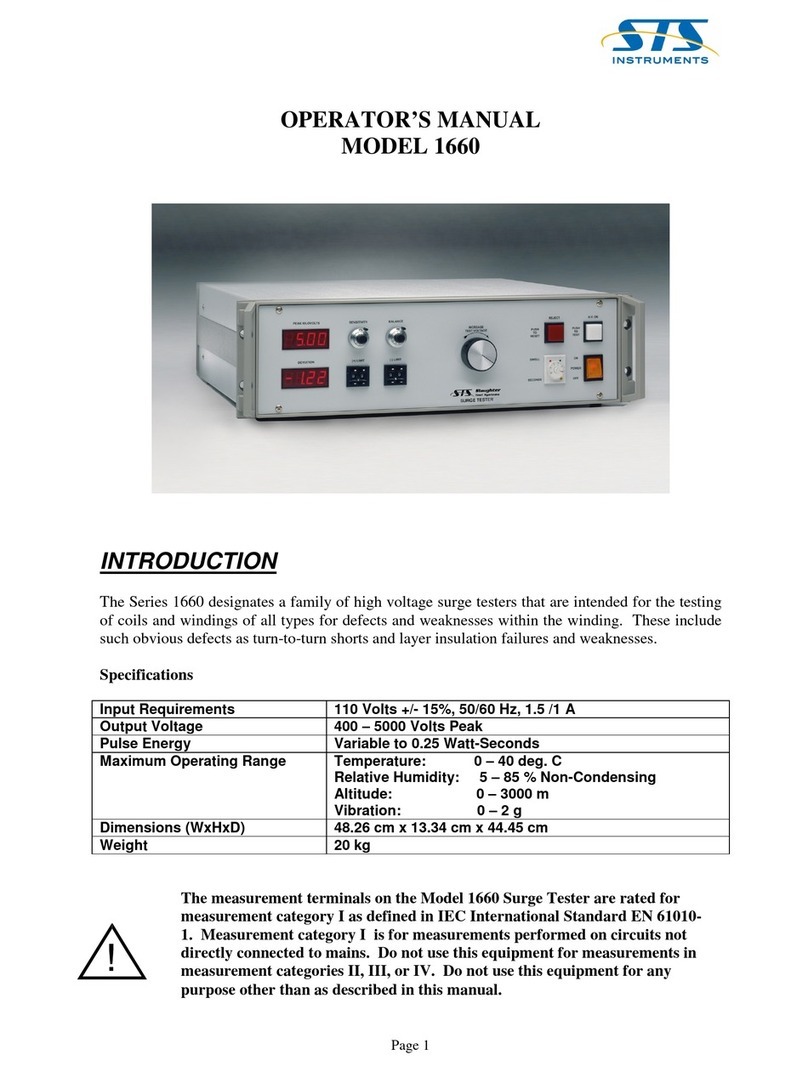
STS
STS 1660 Operator's manual
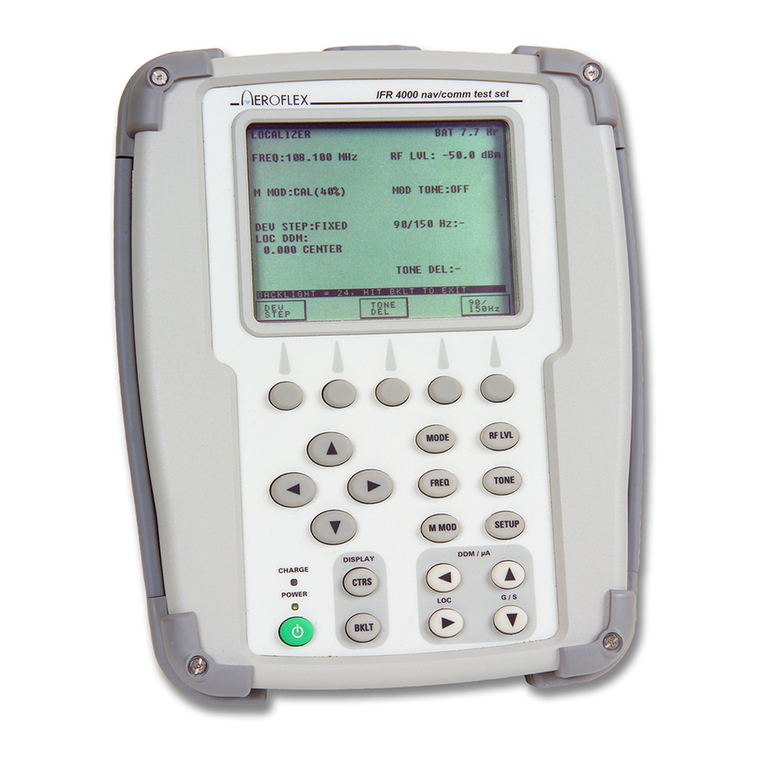
Aeroflex
Aeroflex IFR 4000 Operation manual
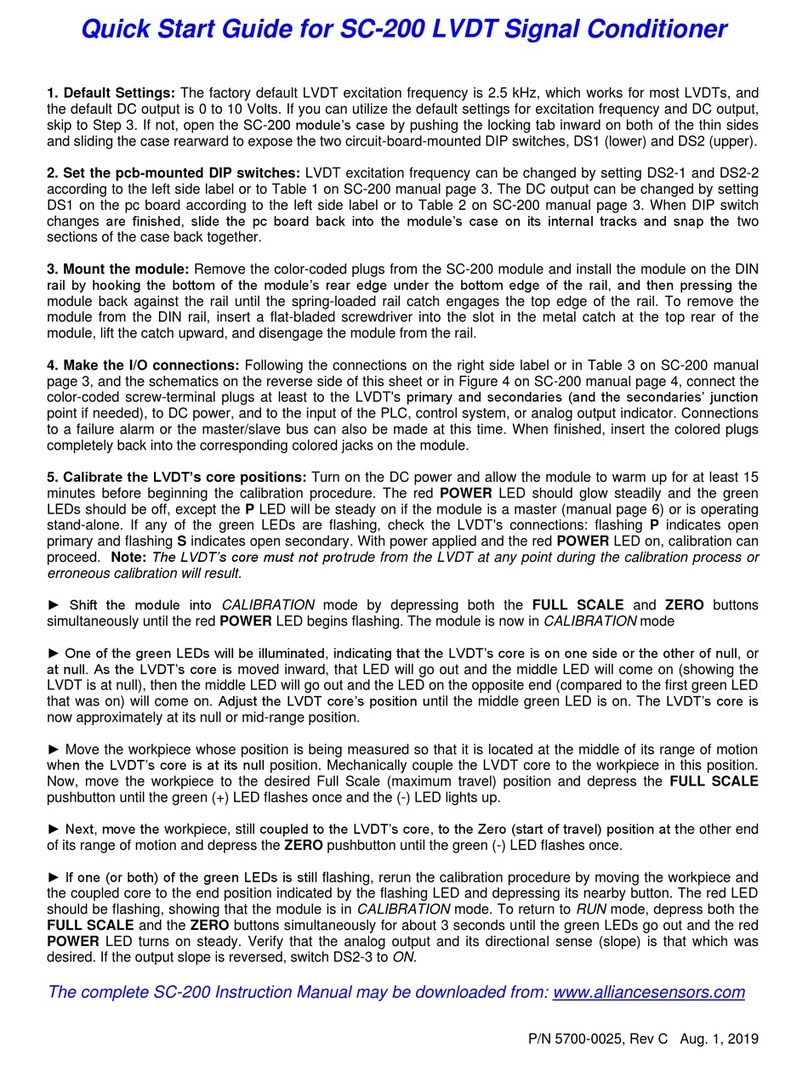
Alliance Sensors
Alliance Sensors SC-200 quick start guide
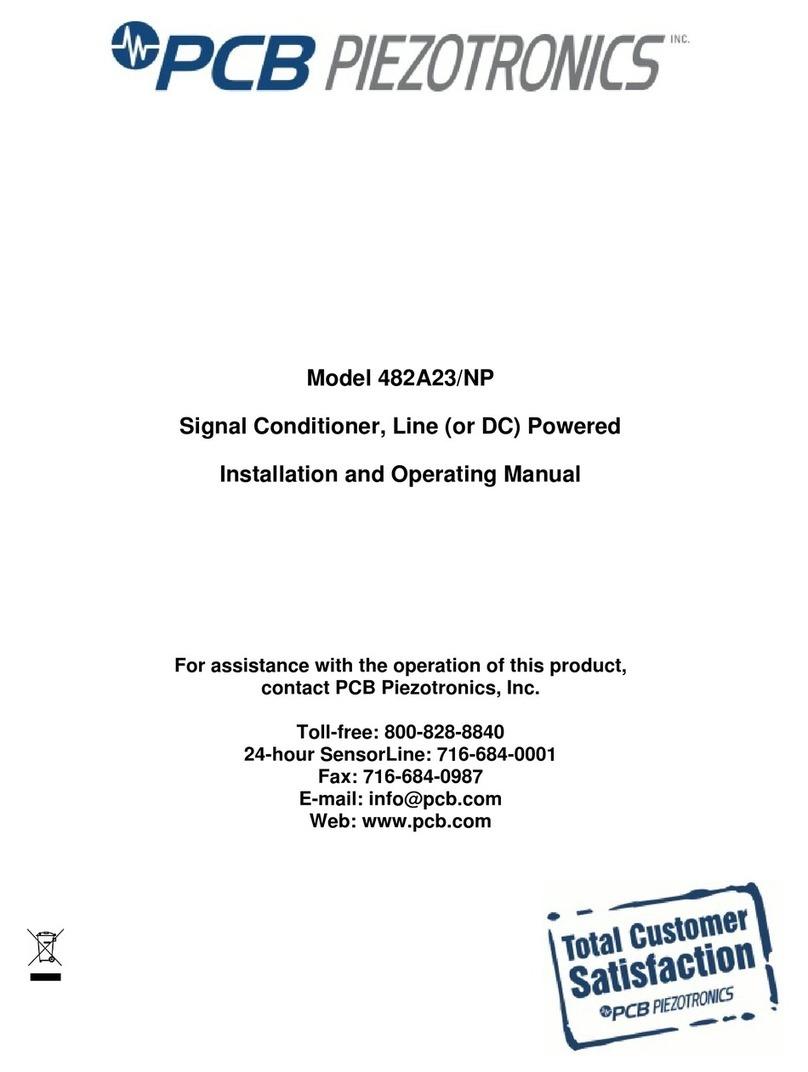
PCB Piezotronics
PCB Piezotronics 482A23/NP Installation and operating manual
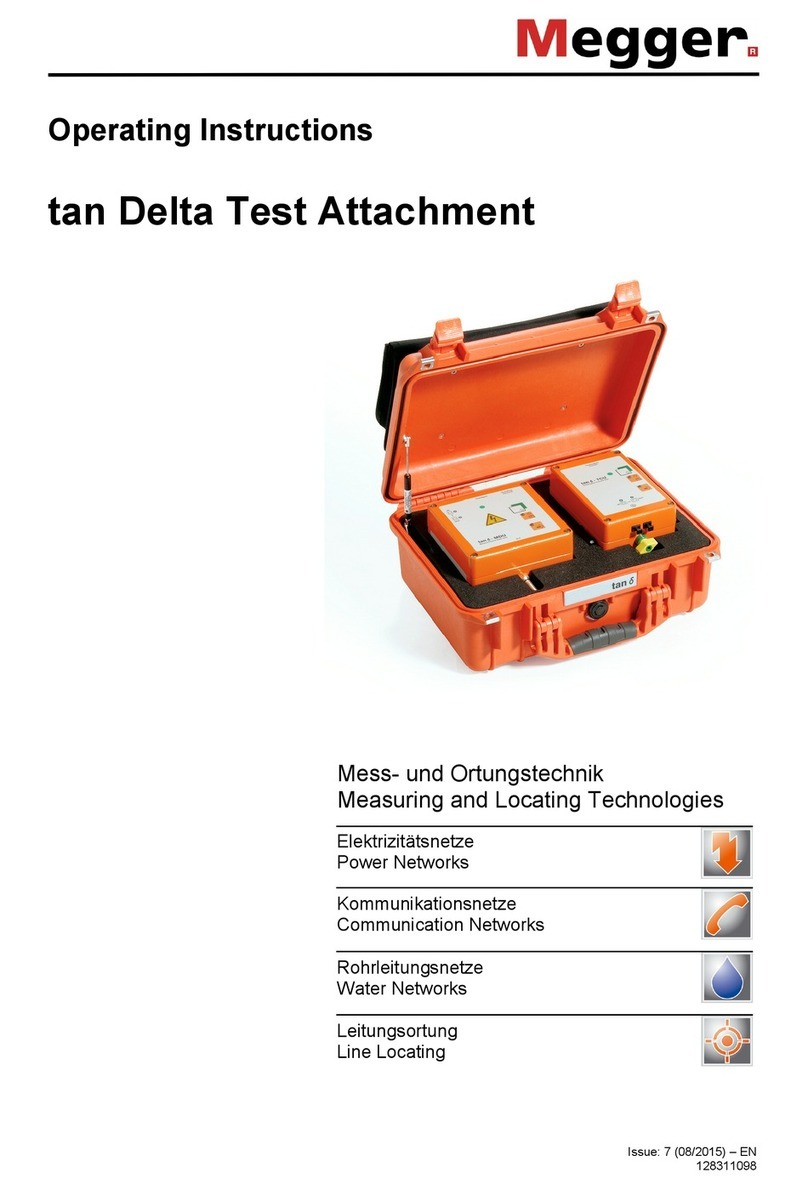
Megger
Megger tan Delta Test Attachment operating instructions
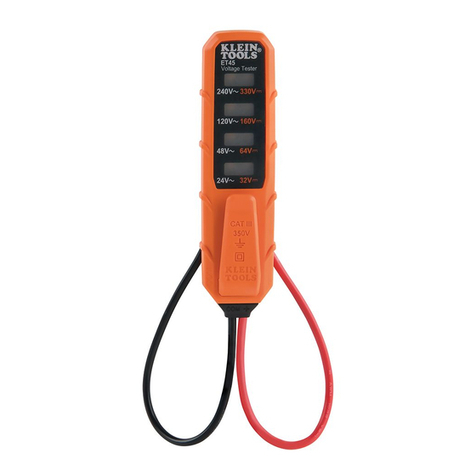
Klein Tools
Klein Tools ET45 instructions


